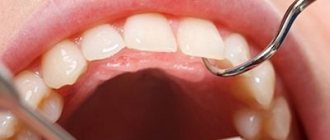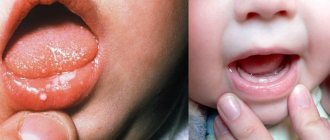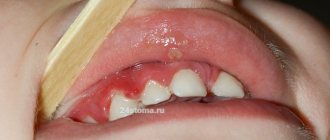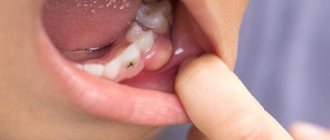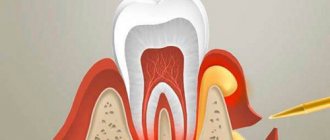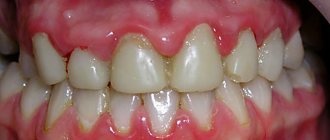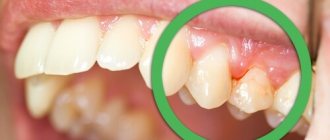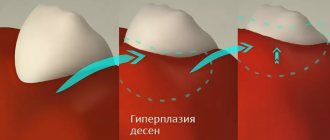Classification of gingivitis according to intensity
- easy
- average
- heavy
The severity of the flow is determined3:
The degree of manifestation of general symptoms - weakness, fever, the presence of enlarged lymph nodes. Changes in condition are also reflected in blood tests. With a mild form, the temperature rises to 37.5°C, with a moderate form up to 38°C, with a severe form - up to 40°C.
Causes of ulcerative-necrotizing gingivitis
Ulcerative-necrotizing gingivitis is caused by fusobacteria and spirochetes. Most often it develops as a complication of catarrhal gingivitis, but it can also be an independent disease. It develops with poor oral hygiene against the background of a sharp decrease in immunity.
General factors
Common factors leading to the onset of the disease are stress, severe fatigue, infectious diseases, and hypothermia. More often the disease is observed in people with diseases of the digestive, endocrine and respiratory systems, heart and vascular diseases. Inadequate and unhealthy diet also increases the risk of developing ulcerative gingivitis. Taking certain medications can also lead to this disease.
Local factors
- Poor oral hygiene In this case, plaque accumulates on the teeth and stones form. With ulcerative necrotic gingivitis, not only ordinary microorganisms accumulate, but also spirochetes.
- Presence of other oral diseases Ulcerative gingivitis can occur as a complication of catarrhal gingivitis and herpetic stomatitis.
- Permanent gum injury For example, old fillings, crowns, dentures.
- Wisdom teeth eruption
- Multiple caries, as it increases the number of pathogens in the mouth
- Injury to the gums by the sharp edges of a carious cavity
- Oral surgery, including complex tooth extraction4
Main causes of gingivitis
Microbial plaque.
In 80–90% of cases, gingivitis is caused by the activity of microorganisms, the nutrient medium for which is dental plaque.
Oral factors:
- uneven functional load on the periodontium - acute and chronic gingivitis can cause malocclusion pathologies, adentia (the absence of several teeth), carious tooth decay, impaired chewing function, and bad habits;
- retention factors - inflammation of the gums is sometimes provoked by poorly polished fillings, poorly installed dentures, caries in the cervical area of the tooth;
- chronic trauma – a factor in the development of acute and chronic gingivitis is often mechanical trauma due to inaccurate brushing of teeth.
Other causes of gingivitis:
- weakened immune system;
- changes in hormonal balance (pregnancy, puberty);
- bad habits;
- general diseases (diabetes mellitus, chronic diseases of the gastrointestinal tract, nervous system, hematopoietic organs).
Up to contents
Symptoms of necrotizing ulcerative gingivitis
The disease develops quickly and rapidly, its symptoms appear very clearly.5,6
- Severe pain that gets worse with the slightest touch or temperature changes
- Swelling of the gums
- Sensitivity of the mucous membrane
- Spontaneous bleeding gums
- The tongue is covered with a green, yellow coating
- Ulcers appear on the surface of the gums, covered with a gray coating.
- A sharply unpleasant, strong odor from the mouth that does not go away even when brushing your teeth
- Increased temperature, weakness, fever
- Necrosis of gum tissue
- Brushing teeth and eating food is difficult
- Lymph nodes are enlarged
- Aches, muscle pain
Forms
Spicy
The first sign is severe sharp pain in the periodontal tissues. The mucous membrane becomes bright red, and it becomes difficult to chew due to swelling and pain.
Chronic
Symptoms of a chronic course are not as pronounced as acute ones. The mouth smells unpleasant; upon medical examination, small ulcers and lesions are found in the area of the gingival margin and gingival papillae. The chronic form occurs in adolescents who systematically ignore hygiene rules.
Chronic gingivitis
Diagnosis of necrotizing ulcerative gingivitis
Diagnosis is made through the clinical manifestations of necrotizing ulcerative gingivitis.7,8
During the examination and questioning, the dentist identifies poor hygiene, bleeding gums, poor general condition and the absence of gum pockets (impaired attachment of the gum to the tooth). Be sure to take a panoramic photograph of all teeth to distinguish ulcerative gingivitis from periodontitis.
Additionally, bacteriological examination and the ELISA method can be carried out to confirm the diagnosis, determine the level of immunoglobulins and select appropriate treatment tactics.
It is important to distinguish ulcerative gingivitis from immunodeficiency conditions and blood diseases. For this purpose, if necessary, other tests may be prescribed.
Prevention of gingivitis
Proper oral hygiene.
To prevent microbial plaque from accumulating on your teeth, you should brush your teeth at least twice a day and use a toothbrush with moderately stiff bristles. During treatment of gingivitis, it can be replaced with a softer brush, but not longer than 2 weeks. To achieve the necessary preventive effect, it is necessary to carefully treat the outer and inner surfaces of the teeth (at least 20 brush strokes). It is recommended to additionally clean the spaces between the teeth with floss. You can use mouth rinses after each meal.
Treatment of ulcerative-necrotizing gingivitis
At the first signs of illness, consult a doctor immediately!
Treatment of ulcerative gingivitis is always complex:
- Anesthesia of the oral cavity with sprays, gels, solutions. With ulcerative gingivitis, this stage is extremely important, since the pain is quite severe.
- Removing the inflammatory process. To do this, use gentle methods to remove plaque and tartar, and be sure to prescribe a course of rinsing with antiseptics for up to two weeks. It is during this visit to the doctor that material is taken for bacteriological examination.
- Removal of general symptoms - fever, headache, for this purpose analgesics and antipyretics are prescribed.
- Destroying pathogenic bacteria, for this purpose antibacterial or antimicrobial drugs are prescribed. (Important! Prescribed strictly by your doctor!)
- Vitamin therapy – to increase the body’s overall resistance to harmful factors.
- During treatment, it is recommended to eat non-irritating foods with sufficient calorie content and not to use spices.
- Treatment of general diseases together with a therapist, gastroenterologist and other specialists.
- After acute inflammation subsides, epithelializing drugs are prescribed (to stimulate tissue healing), professional hygiene, treatment of caries and its complications, removal of wisdom teeth, fillings and crowns (if necessary).
In case of ulcerative gingivitis, it is necessary to strictly follow all the doctor’s recommendations, otherwise complications may arise, and the disease may become chronic.
Removal of dental plaque is carried out under local anesthesia of the gums, using antiseptic drugs, only with the help of hand instruments.
Medicinal preparations containing metronidazole and chlorhexidine are applied to the ulcers, cleared of plaque with special enzymes. These drugs are designed to destroy pathogenic microorganisms, but they should be used only as prescribed by a doctor to avoid complications.
To relieve the inflammatory reaction, local applications with an NSAID solution can be applied for 10-15 minutes.
Acute gingivitis
The clinical picture of acute gingivitis gives classic signs of inflammation: swelling, redness, local increase in gum temperature, pain, disruption of normal gum function. Against this background, bleeding gums and even ulceration are observed. The general condition, with rare exceptions, is not impaired. Upon examination, inflammation of the gum tissue is determined, which extends either to the interdental gingival papillae (papillary gingivitis) or to the marginal gum (marginal gingivitis). The papillae, margin and attached gingiva may be affected (diffuse gingivitis). The intensity of inflammation varies from slight to pronounced. False periodontal pockets may occur due to swelling of the gums. The presence of deposits in the form of tartar or plaque is noted. In the acute form, the gum surface is smooth, shiny, bright red, swollen, and bleeds easily upon probing.
There are: Acute gingivitis caused by dental plaque. This group of gingivitis includes forms that can be caused by: microbial infections, systemic factors, medication, mechanical, thermal and chemical damage.
Gingivitis simplex acuta (simple acute gingivitis) Simple acute gingivitis is a form of gingivitis accompanied by a classic acute inflammatory reaction in response to physical and microbial damage.
Acute necrotizing ulcerative gingivitis This disease, also called Gingivitis acuta ulcerosa necroticans (Plauta-Vincet gingivitis), is characterized by pain, necrosis of the interdental gingival papillae and lymph node reaction. Progressive stages are characterized by the formation of craters with exposed alveolar bone. If left untreated, this disease can progress through necrotizing ulcerative gingivitis-periodontitis into ulcerative stomatitis, and then, in the form of Cancer oris or Noma, lead to death. If the disease is not stopped in time, an irreversible process of tissue loss occurs.
Gingivitis specifica acuta (acute specific gingivitis) Acute specific gingivitis includes specific infectious diseases of the gums as a result of exposure to tuberculosis bacteria, Candida albicans, Actinomyces israelii, Treponema pallidum.
Acute viral gingivitis Gingivitis is caused by herpes simplex viruses, as well as Herpes zoster and cytomegaly.
Gum abscess Gum abscess is an acute disease of the upper gums and leads to purulent melting of the interdental papillae and gingival tissue with the appearance of severe pain.
Complications and outcomes. Acute local gingivitis, when the cause that caused it is eliminated, can result in recovery. Acute generalized gingivitis, when the disease of which it is a complication is eliminated, also usually disappears. Chronically ongoing catarrhal, ulcerative and hypertrophic gingivitis is often a prestage of periodontitis.
Treatment of necrotizing ulcerative gingivitis with Tantum® Verde
Effective treatment of ulcerative gingivitis is possible with the use of anti-inflammatory drugs, which include Tantum® Verde . Benzidamine in its composition has a complex effect on the gums: reduces swelling, relieves inflammation, reduces pain and kills microbes on the surface and inside the affected tissues. Benzidamine penetrates well into the mucous membranes, which allows you to quickly cope with the disease. Tantum®Verde allows you to quickly relieve pain9, which is especially important in the treatment of necrotizing ulcerative gingivitis. From the first minute, Tantum® Verde has an anti-inflammatory and local anesthetic effect on the symptoms of gingivitis, such as a burning sensation, swelling and swelling of the gums. After the acute effects have subsided, it is possible to dissolve Tantum® Verde , since they have an anti-inflammatory effect within 9 minutes, which will allow you to quickly cure gingivitis.10, 11, 12
Prediction and prevention of necrotizing ulcerative gingivitis
If you consult a doctor in time and receive quality treatment, a full recovery is possible. Recurrence of the disease occurs with exacerbation of chronic diseases, a sharp decrease in immunity and poor oral hygiene.
If you postpone going to the doctor and do not follow the recommendations, ulcerative gingivitis can become chronic, which is less treatable, or develop into a more serious disease - periodontitis, which is accompanied by loss of bone tissue. Therefore, it is important to take a responsible approach to the treatment of this disease.
If a person has suffered ulcerative gingivitis, then a second visit is scheduled after 1-2 months, and then you should visit the dentist every six months.
Prevention of ulcerative gingivitis:
- Regular and adequate teeth cleaning
- Visit your dentist for examination and treatment (if necessary) twice a year
- Strengthening the immune system: you should pay attention to such simple things as physical exercise, proper nutrition, sleep patterns, hardening
- Stress management
- Treatment of existing chronic diseases: it is important to avoid exacerbations, otherwise relapses of the disease are inevitable
- Taking vitamins
Treatment of gingivitis
Gingivitis is one of the most common gum diseases, but this does not make it any less dangerous. There are several main forms of gingivitis, each of which is treated differently.
Catarrhal gingivitis
The most common is catarrhal gingivitis . Its main reason is insufficient oral hygiene. The main symptoms of this form of gingivitis are swelling and bleeding of the gums, inflammation of the gums, as well as pain when brushing teeth and redness of the marginal part of the gums. Treatment of this form consists of several stages:
- Removing hard deposits is the most important step, since dental plaque is the cause of gingivitis. Even if inflammation is treated, it will return if pathogenic microorganisms continue to multiply in plaque. Deposits are usually removed using ultrasonic cleaning. After the deposits are removed, the teeth are polished to prevent new plaque from sticking to them;
- Anti-inflammatory therapy is carried out after all deposits have been removed from the teeth. For this purpose, many different means are used, and they are used both at the dentist and at home on the recommendation of a doctor;
- Sanitation of the oral cavity, that is, treatment of all carious teeth. This is necessary in order to prevent the spread of infection and prevent gingivitis from reoccurring;
- Teaching oral hygiene is also a fairly important step. Since gingivitis is caused precisely by insufficient oral hygiene, it is very important to explain to the patient how to properly care for their teeth and gums.
Vincent's ulcerative-necrotizing gingivitis
This form of gingivitis is characterized by increased body temperature, headaches, and enlarged lymph nodes. Necrosis, that is, death of the gums, appears when a specific infection appears in the oral cavity, so treatment must be more radical.
In addition to all those measures that are used in the treatment of catarrhal gingivitis, the removal of necrotic plaque, the use of agents for the regeneration of the gum mucosa, detoxification therapy and systemic antibiotic therapy are also required. Only all these measures taken together will help get rid of this form of the disease.
Hypertrophic gingivitis
The cause of hypertrophic, a rarer form of gingivitis, is endocrine disorders, gingivitis during pregnancy, malocclusion and the presence of local traumatic factors in the oral cavity, for example, crowns or overhanging edges of fillings. Sometimes gum hypertrophy is caused by long-term catarrhal inflammation, but this happens very rarely.
Hypertrophic gingivitis has two forms - edematous and fibrous, and depending on this, different treatments are prescribed in order to get rid of the disease as effectively as possible.
Treatment of edematous form
This form is usually the result of hormonal changes. Swelling of the gums is especially aggravated by both hard deposits and soft plaque, so it is very important to remove all deposits before starting treatment, as well as relieve inflammation with medications.
Sometimes this is enough, but if simple anti-inflammatory therapy does not help, then they move on to sclerotherapy.
Treatment of fibrous form
The cause of this gingivitis is hormonal disorders or a long course of catarrhal gingivitis, as well as constant damage to the gums by artificial structures.
The first step, as in all other cases, is to remove dental plaque and carry out the necessary anti-inflammatory therapy. The overgrown gum tissue is then usually surgically excised, as this is the only way to reduce its size.
After surgery, the patient is prescribed additional anti-inflammatory therapy.
Drugs for the treatment of gingivitis
In the treatment of gingivitis, or rather, at the stage of relieving inflammation, various medications play an important role. Some of these drugs are used in the dentist's office, but some of them are prescribed by the doctor for self-administration.
Typically, patients are prescribed the following for home anti-inflammatory therapy:
- Rinsing with an antiseptic solution
- Applications with anti-inflammatory gels.
In the morning, immediately after breakfast and morning oral hygiene, you need to rinse your mouth for 2 minutes with an antiseptic solution. After rinsing, you should thoroughly dry the oral mucosa with a gauze swab, and then squeeze the gel prescribed for you onto your finger and apply it to the gums around the teeth, both from the outside and from the inside. After applying the gel, it is advisable not to rinse your mouth for two to three hours, and also not to eat anything. When using the gel, salivation may be more active, but you should not be afraid to swallow saliva in the same way as usual. The procedure should be repeated before bedtime.
Toothpaste for gingivitis
Oral hygiene for gingivitis is one of the most important stages of treatment. And even despite the fact that the slightest touch to inflamed gums is usually accompanied by discomfort, your teeth still need to be brushed twice a day, not forgetting about the following treatment procedures.
The toothpaste you use to brush your teeth during gingivitis should be given special attention. It must be medicinal, with special medicinal herbs that have an anti-inflammatory effect. It will be useful if it contains extracts of sage, yarrow, calendula and chamomile or other herbs.
During gingivitis, under no circumstances should you use whitening toothpastes - they are highly abrasive and will only further irritate the gums, exacerbating the inflammatory process. Therefore, teeth whitening should be postponed during treatment of gingivitis - at least until the gums are completely healthy.
Consequences of gingivitis
If gingivitis is not cured in time, it can lead to the next stage of the disease – periodontitis. With periodontitis, the gums bleed even more, and the teeth begin to loosen and fall out. In addition, treatment of periodontitis is a much more difficult and lengthy process, requiring effort, time and large financial investments.
Prevention of gingivitis
To prevent the development of gingivitis, it is enough to follow 4 simple rules that will help avoid many dental problems:
- Brush your teeth every day, morning and evening, and floss and rinse your mouth after meals.
- Visit your dentist at least once every six months for a preventive examination.
- Remove hard plaque and plaque in a timely manner, and treat caries in a timely manner
- Avoid eating sweets, lemonade, and sticky baked goods.
